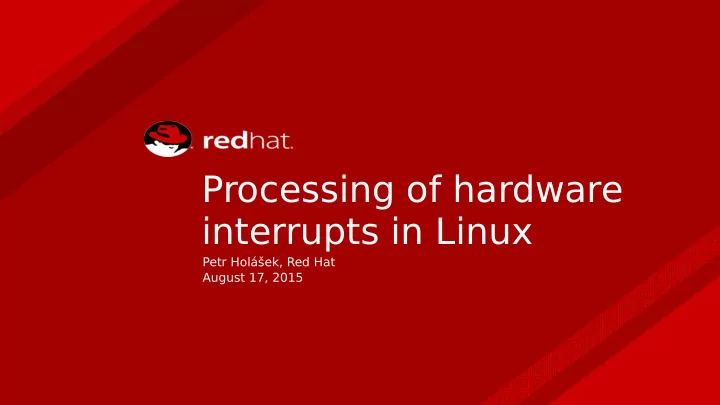

Processing of hardware interrupts in Linux Petr Holášek, Red Hat August 17, 2015
HW and kernel
Interrupt • Hardware interrupt vs softIRQ • Interrupt ReQuest from hardware • In system represented as interrupt vector • Pin-based vs MSI(-X)
Pin-based IRQ • Triggered by electronic signal • Pin can be shared • Possible race condition
MSI(-X) • Message Signaled Interrupts • Introduced with PCI 2.2 • Triggered after write to an address • Improved version called MSI-X
Interrupt controller • APIC LAPIC (local APIC) - at CPU • IOAPIC (I/O APIC) – at device • • Using system bus • APIC bus deprecated
Interrupt handler • Handles received interrupt • Need for speed • Most of the work deferred • Using tasklets or workqueues
Interrupt handler • Multiple CPUs cannot parallelize interrupt handler • Only one interrupt handler running on CPU at time • CPUs can alternate in handling the handler
userspace
Kernel interfaces • The only visible info for user • /proc/interrupts • /proc/irq/<irqnum>/... • /sys/devices/…/irq • /proc/stats
Interrupt affjnity • Mask of possibly receiving processors • /proc/irq/X/smp_affinity • Hexadecimal mask or list • Its value doesn't mean much
Interrupt distribution • Should be done on multiprocessor systems • Storage devices, NICs • Risk of CPU overload or cache misses
Hardware topology • NUMA node • Package • Cache domain – L2 or L3 • CPU • numactl tool
Optimal affjnity layout • Identify and group all high-volume interrupts • Move them to unique single CPUs • Spread out lower-volume interrupts among other CPUs • Do it within the device NUMA node
irqbalance
Irqbalance • Interrupts load balancing daemon • Can improve performance and save power • https://github.com/Irqbalance/irqbalance • Support for NUMA
Irqbalance basics • Balancing of interrupts is complex task • Periodic review of system • Affinity management among heterogeneous systems
Irqbalance basics 2 • Don't migrate interrupt out of home NUMA node • CPU load - time spent in interrupt and softIRQ context
Irqbalance algorithm 1 • Parse all available interfaces • Evaluate overloaded processors • Evaluate the busiest IRQs • Rebalance IRQ on processors
Irqbalance algorithm 2 • Set new smp_affinity values • Wait some time and repeat
Irqbalance options • Can respect affinity_hint set by driver • Can ignore selected IRQs • Can ignore isolated CPUs
Alternatives to irqbalance
“Premature optimization is the root of all evil.” Donald E. Knuth
Manual pinning • Recent irqbalance 1.x addresses most of the discovered bugs • But sometime manual pinning is still better • Real-time, HPC
Rules of manual pinning • Don't set affinity mask to all CPUs • Move affinity to device rather than to process • Let the scheduler do its work • Consider faulty hardware
Kernel IRQ balancing • Dropped by 8b8e8c in 2008 • Return is not planned so far • Interrupt locality ideas
Give irqbalance a second chance • Explore recent version • Some new features are coming soon • Try to compare manual pinning and irqbalance
Recommend
More recommend